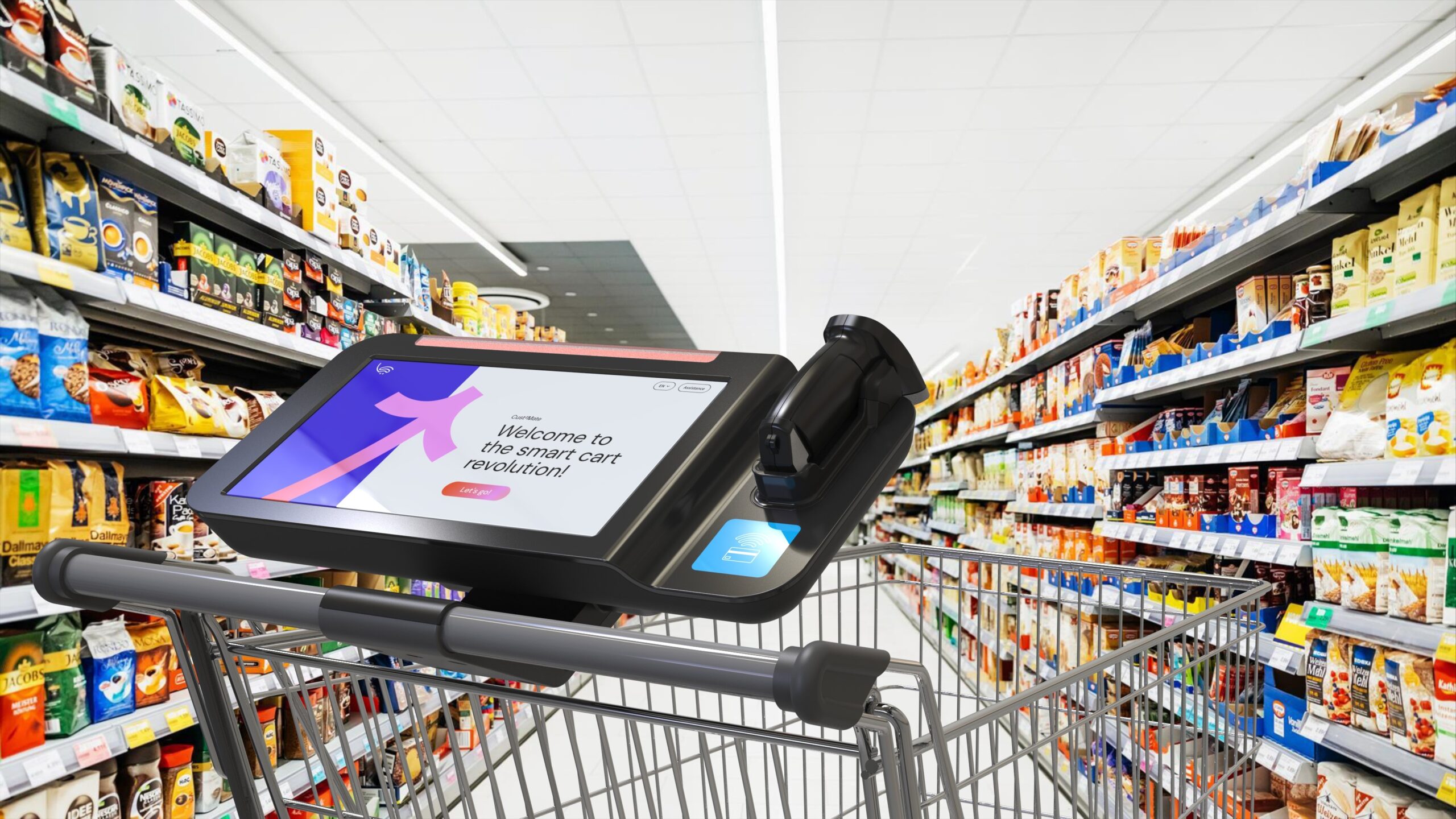This is part 2 of a 3-part series. Part 1 can be read here.
Tomorrow’s tech comprises smart devices to aid consumers’ shopping excursions, the further proliferation of in-store and intra-distributor/warehouse AI, and the further evolution of self-checkout. Here’s a glimpse of what some retail experts foresee for tomorrow’s retail.
Self-Checkout – Down But Far From Out
The proliferation, perceived death, and media blowback of self-checkout has been well documented by The New York Times, The Atlantic, and The Food Institute.
“Self-checkout is a part of the technology journey consumers and retailers are on, but it’s not the destination,” said Andy Keenan, executive vice president and general manager at Advantage Solutions, to TFI in the article linked above, noting that as the technology advances, how grocers and retailers implement it will depend upon how consumers respond, and despite the challenges it presents, the number of self-checkout lanes has increased by 10% in the last five years.
Some see a way forward; others see technology leapfrogging the lane entirely. It’s a classic case of the Schrodinger’s Cat paradox – until the future tech is definitive, self-checkout will both thrive and struggle in equal measure; it all depends who you ask.
“Self-checkout exploded in the pandemic, but with the increase of retail theft, retailers are recognizing that the costs of shrink associated with fewer associates outweighs the value of reducing labor costs,” Gottlieb noted. “In the future, retailers will begin to move away from self-checkout and shift their focus towards loss prevention.”
Another way of thinking about it is that the notion of self-checkout may move from the retail floor kiosk directly to the retail consumer’s pocket by way of the smartphone. Sarah Jarvis is Propositions Director at Eagle Eye, a retail personalization and development company, who sees shopping becoming more of a “phone out” activity as technology accelerates toward a truly seamless omnichannel experience.
“We envision that smartphones will become customer companions that augment the in-store experience,” she told TFI. “Retailers will develop intuitive apps that will act as personal shopping assistants, supporting customers throughout their journeys pre-, during, and post-transaction.”
For many big-box or warehouse retailers, aspects of that reality already exist. Still, the notion of self-checkout may proliferate as brands make their apps more essential to a value-driven in-store experience.
“For example, app users inside Nike stores can scan a QR code to summon shoes – in their size – to try on,” she offered. “They can ‘shop the look’ using their smartphone’s camera or checkout instantly using integrated payment options within the app. Other retailers can adopt this approach and, in the process, augment the brand relationship and the in-store experience.”
Seen most often at sports stadiums and other large entertainment arenas, the further proliferation of “just walk out” technology will continue to offer consumers what they want – just faster and more conveniently than what they’re used to today, which is hard to imagine.
Whether or not tech-forward consumers employ every digital and seamless option available to them, retailers and grocers will still have to contend with the average consumer and their No. 1 tool as they have for decades – the shopping cart. But tomorrow’s shopping cart is much more than a box on wheels.
Smart Carts Enhance Shopping Lists & Nutrition
Guy Mordoch is CEO of Cust2Mate, a smart shopping cart solutions company. Smart carts offer a digital tablet on or near the handle in which customers can upload their shopping lists before even entering the store, and from solving the salesman’s problem of the most efficient route to offering digital and in-store coupons that match a customer’s purchase history and dietary/nutrition needs, tomorrow’s cart will offer further solutions for value, convenience, and discovery.
Cust2Mate has a large commercial deployment in Israel with Yochananof, one of its largest grocery chains. Mordoch provided the following data from their deployment there:
- Average basket size up to 75% larger than regular carts & self-checkout
- 75% returning shoppers
- 43 average items per cart
- Up to four cashier lines removed
Yochananof deputy CEO Elad Harazi said, “Yochananof shoppers express great satisfaction with the shopping experience carried out using the Cust2Mate smart cart. As a chain that is always at the forefront of advanced technology in the field of retail, we are happy to continue and purchase more carts and increase the layout in more branches.”
“Smart carts serve as a bridge between the physical store and the digital world, providing an omnichannel approach that creates a holistic understanding of shoppers for brick-and-mortar grocers,” Mordoch offered. “Smart carts present physical retailers with the opportunity to replace traditional self-checkout methods … and actually digitize the shopping journey.”
Our smart cart offers shoppers a completely frictionless experience and improves their engagement and satisfaction,” he concluded. “We have seen that enabling on-cart payments (a ‘pick and go’ functionality allowing shoppers to pay using digital wallets, credit cards, PayPal, and even cryptocurrencies) streamlines the checkout process, reducing time spent on waiting on lines and effectively increasing the shopping time.”
Cust2Mate has also found success with French retail giant Carrefour. Carrefour piloted the carts in June 2023 and by December announced it would deploy over 2,400 carts throughout the country, the largest implementation to date of the smart cart technology.
AI for Operations and Supply Chain
As AI advances, operators will have to advance their hardware (and hardware budgets) along with it. And that’s just on the product end – there’s a whole other level of possibilities once spatial computing comes to the forefront of conventional retail.
“For AI to really work for the folks on the retail floor, it needs to get the physical world around it. That’s where spatial computing shines,” said Nils Pihl, CEO of Auki Labs, to TFI. “It’s not just about slapping a virtual TV screen in the air – retailers can use it to anchor all sorts of useful things in their space, like tasks and info, right where their staff need it.”
Pihl said solving this dilemma could slash training costs by billions. He knows the consumer side is flashy, “but whoever cracks spatial computing in retail – bringing AI right to the shop floor – that’s the one who may come out on top.”
Pihl points out that without spatial computing, AI’s advantages are probably skewed toward e-commerce, putting conventional brick-and-mortar stores at a significant disadvantage. Pihl said it may seem like a dire situation for brick-and-mortar stores, but the advent of spatial computing in the future will change the game once more: “Imagine a computer that truly understands its physical surroundings. This is more than just tech jargon; it’s the key for AI to effectively join the retail frontlines, revolutionizing how we manage and experience physical stores,” allowing real-world spaces to harness AI as effectively (and remain competitive with) e-commerce markets, “an essential factor in the ongoing evolution of the retail industry.”
Much is also poised to change on the supply side as well.
“In the future, AI will play a significant role in creating a leaner supply chain that doesn’t fail consumers,” said David Gottlieb, CRO at Trax Retail, to TFI. “Brands and retailers will be able to make more-exact estimates of how many products to order – which will ultimately reduce costs and ease supply chain issues.”
Gottlieb added that while many global supply chain bottlenecks have eased since the peak of the pandemic, out-of-stock issues persist from Target to Costco, Sam’s Club to Hy-Vee, and more. When items aren’t available in the e-commerce world, consumers are much more likely to spend their money elsewhere.
To further understand how inventory and supply chain will change, Jarvis said the end of data silos must be achieved “to create a holistic understanding of each shopper, their interactions, and the stream of information being shared with them.
“We predict that barriers between sales and marketing channels will continue to blur and dissolve, allowing for a more consistent flow of data to deliver more detailed and accurate customer insights,” she added. “This approach to channel-merging and silo-ending translates to improved consumer experiences, with insights being leveraged to provide precise predictive recommendations and dynamic content customization that boost engagement.”
Jarvis noted that achieving personalization at scale and delivering individualized customer experiences at every phase of the buying journey can only happen if the most basic needs of the consumer are met – is the product in stock, and can it be delivered as promised in as brief, inexpensive, and efficient time frame as possible?
AI will help achieve that. What else it will help manufacturers, managers, and operators do is just beginning to be understood.
Stay tuned for Part 3 of The Future of Retail – “The Immersive Retail Environment”












